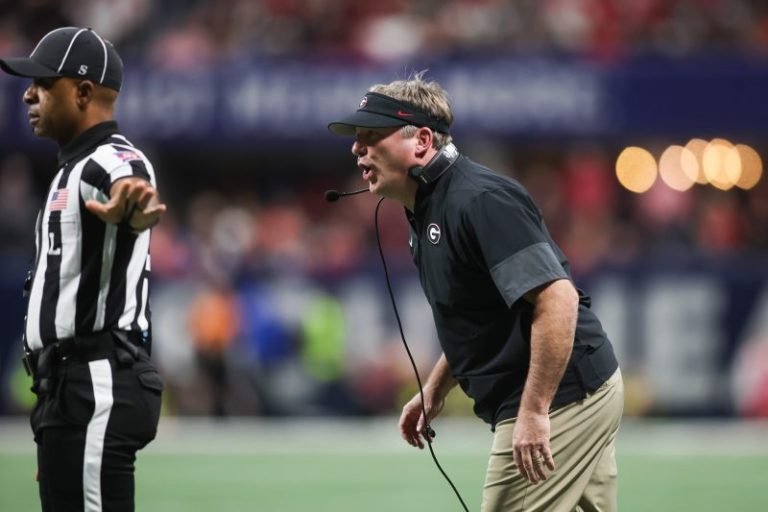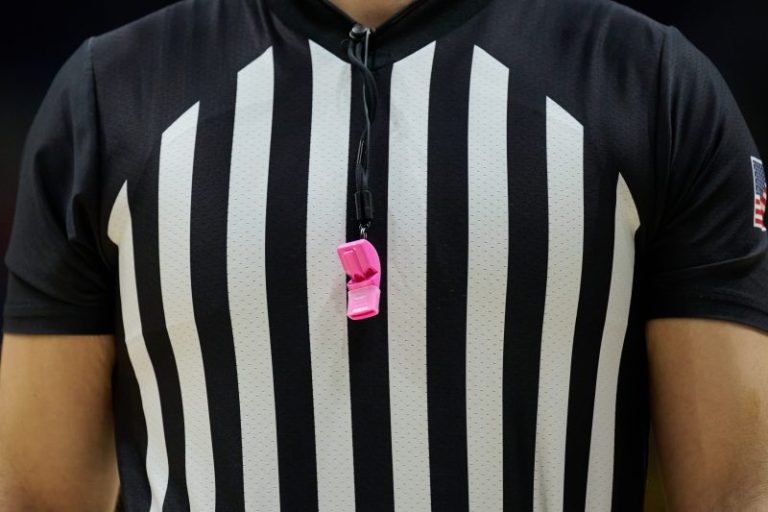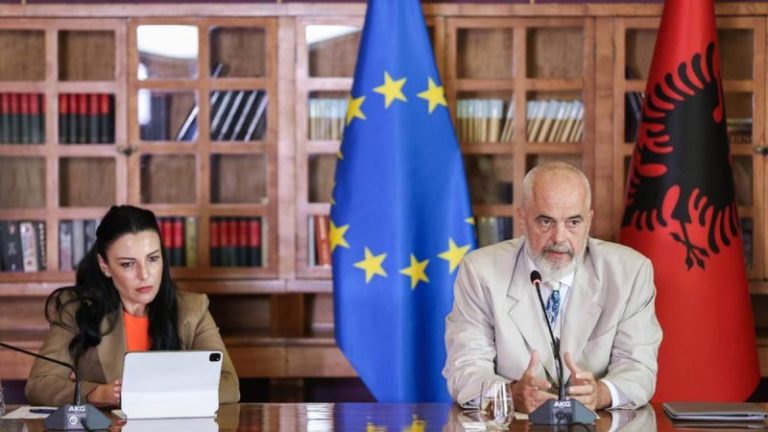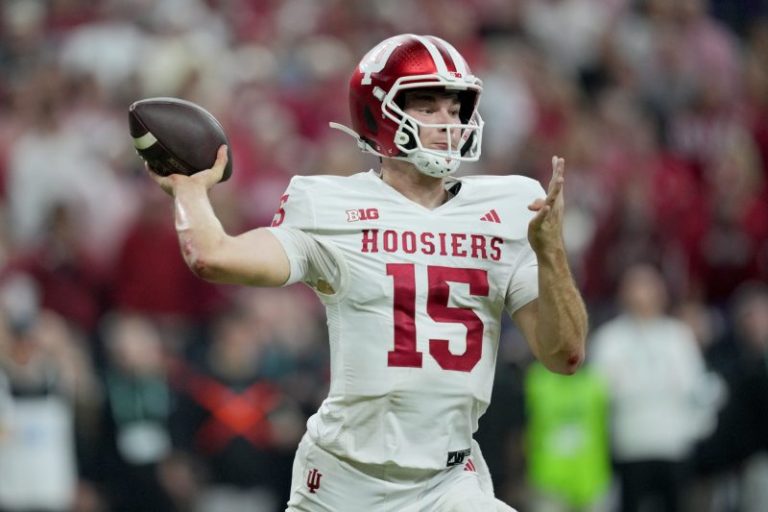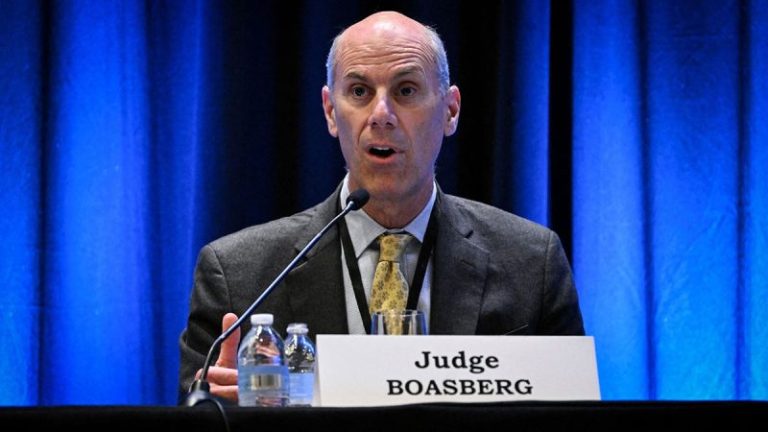Sweet 16 action concluded in the 2025 NCAA volleyball tournament with four games Friday.
No. 1 seed Texas kicked off the day by sweeping Indiana. No. 1 overall seed Nebraska ended the night with a sweep of Kansas. Wisconsin took down Stanford and Texas A&M shocked Louisville with a comeback win.
No. 1 Kentucky and No. 1 Pittsburgh punched their tickets to the Elite Eight on Thursday. The Wildcats ended Cal Poly’s Cinderella story in straight sets, while Pittsburgh brought out the brooms against Minnesota.
Next up, Kentucky takes on No. 3 Creighton at 5 p.m. ET Saturday, followed by Pittsburgh vs. No. 3 Purdue. Sunday, Nebraska and No. 3 Texas A&M fight for a trip to the semifinals, along with Texas and No. 3 Wisconsin.
USA TODAY gives you everything you need to know about Friday’s matches and highlights:
SWEET 16 NCAA VOLLEYBALL RECAP: Kentucky, Pittsburgh sweep way to Elite Eight
FINAL SCORE: Nebraska 3, Kansas 0
The Huskers have now won 29 straight NCAA tournament matches at home. Andi Jackson (nine kills on .600 hitting) and Rebekah Allick (nine kills on 1.000 hitting) combined for 18 kills with no errors. Nebraska hit .450 collectively, while holding Kansas to .029 hitting.
Set 3: Nebraska 25, Kansas 12
Nebraska sweeps Kansas to advance to the Elite Eight on Sunday, where they will face Texas A&M.
Nebraska was in the driver’s seat once again and was the first team to reach 15 points in the third set, leading 15-8. The Huskers were hitting .762 at that point, compared to Kansas’ .353.
Set 2: Nebraska 25, Kansas 11
No. 1 Nebraska went on a 5-0 run to claim the second set, 25-11. The Huskers have been dominant on both sides of the ball, recording 22 kills and 17 total blocks through the first two sets, all while holding Kansas to a negative hitting percentage (-.039).
The Huskers cruised through the first set, but the second set started out much closer. Kansas cut Nebraska’s lead to 9–7, but the Huskers responded with a 4–0 run to go up 13–7. Rebekah Allick has been the hot hand, with nine kills on nine attempts, hitting a perfect 1.000.
Set 1: Nebraska 25, Kansas 12
Nebraska took a quick lead against Kansas and easily put away the first set.
The Cornhuskers looked every bit like the No. 1 overall seed. They collectively hit .357 and registered six blocks against the Jayhawks, who were held to a negative hitting percentage (-.024) in the first set. Rebekah Allick led the Huskers with six kills on six attempts, while Andi Jackson added four blocks and three kills.
Nebraska vs. Kansas volleyball underway
Nebraska volleyball arena expansion
Nebraska volleyball is so successful, it’s home court at John Cook Arena will be expanded to 10,000 seats ahead of the 2026 season.
The Nebraska Athletic Fund released renderings and details for the plan earlier this week. The addition of about 2,000 seats also means there will be a ‘comprehensive reseating of season tickets,’ according to the school fundraising site.
FINAL SCORE: Texas A&M 3, Louisville 2
Set 5: Texas A&M 3, Louisville 2
No. 3 Texas A&M completed a reverse sweep against No. 2 Louisville to advance to the regional final for the first time since 2001 after winning the fifth set, 15-12. The Aggies were able to swing the momentum of the game with their blocking ability, led by Ifenna Cos-okpalla’s 12 total blocks.
Texas A&M’s Logan Lednicky (20 kills, 10 digs on .245 hitting), Kyndal Stowers (16 kills, 11 digs on .282 hitting) and Emily Hellmuth (12 kills on .226 hitting) each recorded double-digit kills.
‘We just weren’t finishing the last end of the set,’ said an emotional Lednicky, who was three blocks away from a triple double. ‘We’re like, we’re not letting them sweep us. We know how to grind, we know how to dig it. We saw it in the TCU match and we did just that last one.’
Tensions boiled over in the fifth set. Louisville head coach Dan Meske earned a yellow card for swatting the ball because he thought the referee missed a carry call during a long rally Texas A&M won to go up 12-10.
Louisville’s Chloe Chicoine finished with a game-high 26 kills hitting .300 in the loss.
Set 4: Louisville 2, Texas A&M 2
No. 3 Texas A&M took a 17-8 lead after holding No. 2 Louisville to a -.143 hitting percentage to start the fourth set with its defensive prowess. The Aggies stretched their lead to as many as nine points, but Louisville went on a 7-1 run to come within three points of Texas A&M. The Aggies didn’t relinquish the lead this time. Texas A&M finished the fourth set on a 4-0 run to force a decisive fifth set.
Texas A&M held Louisville to .000 hitting in the fourth set. The Aggies hit .267 and recorded nine blocks. Texas A&M’s Logan Lednicky (18 kills on .333 hitting), Kyndal Stowers (14 kills on .243 hitting) and Emily Hellmuth (10 kills on .200 hitting) each have double-digit kills. Ifenna Cos-okpalla is up to 11 blocks.
The Aggies are going for the reverse sweep, the team’s first since September 2024.
Set 3: Louisville 2, Texas A&M 1
No. 3 Texas A&M head coach Jamie Morrison said his team needed to do a better job at finishing at the end of the set if they wanted to extend their season against No. 2 Louisville after giving up leads in the first two sets. The Aggies did just that in a third set that featured 15 ties and five lead changes.
The Aggies had a 23-21 lead in the third set before Louisville tied it up at 23-23 following back-to-back kills from Chloe Chicoine. Texas A&M’s Kyndal Stowers responded with a pair of kills herself to give the Aggies the set, 25-23.
Texas A&M’s Logan Lednicky (14 kills on .333 hitting), Kyndal Stowers (11 kills on .259 hitting) and Emily Hellmuth (10 kills on .261) each have double-digit kills as the team is collectively hitting .292.
Meanwhile, Chicoine is up to 19 kills on .405 hitting. Cara Crease added seven blocks.
Set 2: Louisville 2, Texas A&M 0
New set, same scenario. Much like the first set, Texas A&M was the first team to reach 15 points. The Aggies had a 21-16 lead in the second set, before Louisville staged another comeback. The Cardinals went on a 9-1 run to take the lead and clinch the second set, 25-22, to take a 2-0 lead over Texas A&M.
Louisville capitalized on 14 total blocks and three aces. Chloe Chicoine (11 kills on .400 hitting) and Payton Petersen (10 kills on .563 hitting) led the Cardinals in kills.
Logan Lednicky has nine kills, while Emily Hellmuth and Kyndal Stowers each have seven kills for Texas A&M.
Set 1: Louisville 1, Texas A&M 0
No. 3 Texas A&M had control of the first set and was the first team to 15 points, but No. 2 Louisville went on a 5-0 run to tie it up at 17-17. Five more ties ensued before Louisville ultimately created some separation to take the first set, 25-23. Louisville hit .457 and had two players with six or more kills — Payton Petersen (seven kills on .778 hitting) and Chloe Chicoine (six kills on .600 hitting).
Louisville starters
FINAL SCORE: Wisconsin 3, Stanford 1
Set 4: Wisconsin 25, Stanford 22
The Badgers had to fight for it, but they moved on after a 3-1 win over Stanford that was sealed with a team block. Wisconsin finished the day hitting .420. Mimi Colyer had a blistering 27 kills on .373 hitting and 10 digs. On the other side of the net, Stanford hit well for most of the match, but slipped to a .242 percentage in the fourth set after maintaining around .400 during the first three sets. The Cardinal had four players who finished with double-digit kills. Elia Rubin led the group with 15 kills and 13 digs.
Set 3: Wisconsin 25, Stanford 23
The third set was a back-and-forth battle. There were a whopping nine ties and four lead changes before Wisconsin finally pulled away to go up 2-1. Grace Egan sealed the third set for the Badgers with a timely kill after two set points. Mimi Colyer continues her day of domination with 19 kills on .333 hitting. Carter Booth has also been fantastic for Wisconsin with 13 kills on .813 hitting. Julia Blyashov and Jordyn Harvey both have 10 kills for Stanford.
Set 2: Stanford: 25, Wisconsin 21
Stanford was poised with better defense and serving. The Cardinal were tied with the Badgers at 13 before letting off a 12-8 run to take the set. Elia Rubin had the deciding kill after three set points. Stanford hit .484 with three players who had six or more kills, including Rubin, who had a .417 hitting percentage and seven digs. Wisconsin’s Mimi Colyer leads all players with 16 kills on 25 swings and .480 hitting.
Wisconsin vs. Stanford is a sister-against-sister showdown
Look across the court, and fans will see a pair of sisters on opposite sides of the court. Wisconsin’s Alicia Andrew and Stanford’s Lizzy Andrew are facing off against each other today in the Sweet 16.
Set 1: Wisconsin 25, Stanford 17
Wisconsin hit a blistering .514 in the first set, sealed by a Carter Booth kill. Mimi Colyer led the Badgers with nine kills on 15 swings and a .467 hitting percentage. Lizzy Andrew led the Cardinal, going a perfect three-for-three on kills.
Wisconsin vs. Stanford is underway
No. 3 Wisconsin and No. 2 Stanford are in the first set of the second match of day two of the Sweet 16.
Texas star Cari Spears had her dad in the stands against Indiana
Former NFL player and ESPN analyst Marcus Spears was in the stands today to watch his daughter, Texas freshman Cari Spears, play.
FINAL SCORE: Texas 3, Indiana 0
Set 3: Texas 25, Indiana 22
Whitney Lauenstein sent Texas to the regional final with a kill to secure the sweep against Indiana. The Longhorns finished with .374 hitting and 23 total blocks. Torrey Stafford was brilliant with 19 kills on 28 swings (with zero errors) and a .679 hitting percentage. Nya Bunton was also critical to the Longhorns’ success with seven kills on .545 hitting and five blocks. Candela Alonso-Corcelles and Jaidyn Jager had 21 combined kills for the Hoosiers.
Indiana is pushing Texas in Set 3
The Hoosiers look much more relaxed in the third set as they try to fight off elimination. They are hitting .261 in the frame and have slowed down Texas’s blocks.
Set 2: Texas 25, Indiana 22
It took four set points, but Abby Vander Wal again secured the set Texas. The Longhorns have held the Hoosiers to under .200 for the match while maintaining .365 hitting percentage. Torrey Stafford is putting on a clinic from all over the court. Stafford has zero errors on 19 swings, including 15 kills and a .789 hitting percentage. Candela Alonso-Corcelles leads Indiana with seven kills on .125 hitting and six digs.
Texas’s defense is rolling against Indiana
The Longhorns have 17 total blocks and have held Indiana to a .088 hitting percentage in the second set and .127 hitting for the match.
Set 1: Texas 25, Indiana 20
Texas took the first set after two set points, with Abby Vander Wal landing the deciding point. As a team, Texas hit .323 in the set, compared to .162 for Indiana with nine errors. The Hoosiers had several runs to close the game with the Longhorns, but Texas was too much. Torrey Stafford led all players with six kills on .750 hitting.
Texas is the first to 15 in Set 1 against Indiana
The Longhorns reached 15 points behind a huge boost from outside hitter Torrey Stafford, who had five kills and two blocks.
Indiana vs. Texas is underway
The Indiana Hoosiers and Texas Longhorns are in the first set of the first match during Day 2 of the Sweet 16.
NCAA volleyball Sweet 16 continues Friday
Two No. 1 seeds play on Friday, with Texas playing Indiana in the opener. The top overall seed, Nebraska, puts its unbeaten streak on the line against No. 4 Kansas in the nightcap after opening the tournament with back-to-back sweeps.
When is NCAA women’s volleyball Sweet 16?
Date: Dec. 12
Time: Four matches beginning at noon ET Friday. Match-by-match times below.
How to watch NCAA volleyball tournament
Streaming: ESPN+ ∣ Fubo (free trial)
The 2025 NCAA women’s volleyball tournament will air across the ESPN and ABC family of networks. Games can be streamed ESPN+, ESPN’s subscription streaming service, and Fubo, which offers a free trial to potential subscribers.
NCAA volleyball Sweet 16 schedule: Times, TV
All times Eastern
Thursday, Dec. 11
No. 3 Creighton 3, No. 2 Arizona State 1
No. 1 Kentucky 3, Cal Poly 0
No. 1 Pittsburgh 3, No. 4 Minnesota 0
No. 3 Purdue 3, No. 2 SMU 1
Friday, Dec. 12
No. 1 Texas 3, No. 4 Indiana 0
No. 3 Wisconsin 3, No. 2 Stanford 1
No. 3 Texas A&M 3, No. 2 Louisville 2
No. 1 Nebraska vs. No. 4 Kansas, 9:30 p.m. | ESPN2
Saturday, Dec. 13
No. 3 Creighton vs. No. 1 Kentucky, 5 p.m. | ESPN2
No. 1 Pittsburgh vs. No. 3 Purdue, 7:30 p.m. | ESPN2
Sunday, Dec. 14
No. 1 Nebraska vs. No. 3 Texas A&M, 3 p.m. | ABC
No. 1 Texas vs. No. 3 Wisconsin, 7:30 p.m. | ESPN
When is the NCAA volleyball Final Four in 2025?
Dates: Thursday, Dec. 18 and Sunday, Dec. 21
The two semifinal matches in the Final Four of the 2025 NCAA volleyball tournament will take place on Thursday, Dec. 18 and will be broadcast on ESPN. The national championship game is Sunday, Dec. 21 on ABC.
NCAA volleyball second-round results
Lexington bracket
No. 1 Kentucky 3, No. 8 UCLA 1 (30-28, 25-16, 28-30, 25-17)
No. 3 Creighton 3, No. 6 Northern Iowa 1 (25-18, 23-25, 25-22, 25-21)
No. 2 Arizona State 3, Utah State 1 (25-15, 25-18, 22-25, 25-15)
Cal Poly 3, No. 4 USC 2 (25-19, 25-20, 20-25, 14-25, 15-7)
Austin bracket
No. 4 Indiana 3, No. 5 Colorado 0 (25-20, 25-17, 25-23)
No. 3 Wisconsin 3, North Carolina 0 (25-14, 25-21, 27-25)
No. 1 Texas 1, No. 8 Penn State 0 (25-16, 25-9, 25-19)
No. 2 Stanford 3, Arizona 1 (25-16, 25-27, 25-17, 25-20)
Pittsburgh bracket
No. 3 Purdue 3, No. 6 Baylor 1 (25-16, 25-19, 23-25, 25-20)
No. 1 Pittsburgh 3, Michigan 0 (25-23, 25-23, 25-18)
No. 2 SMU 3, Florida 0 (25-11, 25-21, 26-24)
No. 4 Minnesota 3, No. 5 Iowa State 0 (25-22, 25-21, 25-14)
Lincoln bracket
No. 4 Kansas 3, No. 5 Miami 1 (25-17, 25-22, 22-25, 27-25)
No. 2 Louisville 3, Marquette 2 (21-25, 25-11, 23-25, 25-19, 15-12)
No. 1 Nebraska 3, Kansas State 0 (25-17, 25-21, 25-16)
No. 3 Texas A&M 3, No. 6 TCU 1 (23-25, 25-23, 25-22, 29-27)
NCAA volleyball first-round results
Lexington bracket
No. 1 Kentucky 3, Wofford 0 (25-11, 25-19, 25-12)
No. 8 UCLA 3, Georgia Tech 2 (24-26, 25-19, 25-23, 25-18, 15-10)
Cal Poly 3, No. 5 BYU 2 (25-19, 17-25, 20-25, 25-20, 15-10)
No. 4 USC 3, Princeton 0, (25-19, 25-12, 25-13)
No. 3 Creighton 3, Northern Colorado 2 (12-25, 25-23,25-23,17-25, 8-15)
No. 6 Northern Iowa 3, Utah 2 (15-25, 21-25, 26-24, 25-20, 15-10)
Utah State 3, No. 7 Tennessee 2 (25-19, 25-15, 19-25, 25-18, 15-11)
No. 2 Arizona State 3, Coppin State 0 (25-11, 25-14, 25-12)
Austin bracket
No. 1 Texas 3, Florida A&M 0 (25-11, 25- 8, 25-14)
No. 8 Penn State 3, South Florida 1 (25-23, 12-25, 25-21, 25-19)
No. 5 Colorado 3, American 0 (25-16, 25-19, 25-16)
No. 4 Indiana 3, Toledo 0 (25-18, 25-15, 25-17)
No. 3 Wisconsin 3, Eastern Illinois 0 (25-11, 25-6, 25-19)
North Carolina 3, No. 6 UTEP 1 (24-26, 25-11, 25-18, 25-21)
Arizona 3, No. 7 South Dakota State 1 (25-21, 22-25, 25-15, 25-15)
No. 2 Stanford 3, Utah Valley 1 (21-25, 25-21, 25-13, 25-14)
Pittsburgh bracket
No. 1 Pitt 3, UMBC 0 (25-10, 25-17, 25-13)
Michigan 3, No. 8 Xavier 0 (25-19, 25-15, 25-23)
No. 5 Iowa State 3, St. Thomas-Minnesota 2 (21-25, 25-13, 25-16, 21-25, 15-8)
No. 4 Minnesota 3, Fairfield 0 (25-12, 25-7, 25-13)
No. 3 Purdue 3, Wright State 0 (25-13, 25-21, 25-19)
No. 6 Baylor 3, Arkansas State 2 (23-25, 25-20, 30-28, 23-25, 15-10)
Florida 3, No. 7 Rice 0 (27-25, 25-23, 25-19)
No. 2 SMU 3, Central Arkansas 0 (25-13, 25-13, 25-13)
Lincoln bracket
No. 1 Nebraska 3, Long Island 0 (25-11, 25-15, 25-17)
Kansas State 3, San Diego 2 (21-25, 25-17, 26-28, 25-22, 15-12)
No. 5 Miami 3, Tulsa 1 (25-22, 13-25, 25-22, 25-20)
No. 4 Kansas 3, High Point 0 (25-20, 25-15, 25-18)
No. 3 Texas A&M 3, Campbell 0 (25-20, 25-10, 25-13)
No. 6 TCU 3, Stephen F. Austin 0 (25-8, 26-24, 25-20)
Marquette 3, Western Kentucky 0 (25-22, 25-21, 25-16)
No. 2 Louisville 3, Loyola (Illinois) 0 (25-17, 25-9, 25-12)
NCAA volleyball tournament champions
Penn State is the reigning NCAA volleyball champion, having defeated Louisville in four sets last year in the national title game. It was the Nittany Lions’ eighth volleyball championship since 1999.
Here’s a look at the past 10 NCAA volleyball champions:
2024: Penn State
2023: Texas
2022: Texas
2021: Wisconsin
2020: Kentucky
2019: Stanford
2018: Stanford
2017: Nebraska
2016: Stanford
2015: Nebraska
The USA TODAY app gets you to the heart of the news — fast. Download for award-winning coverage, crosswords, audio storytelling, the eNewspaper and more.
This post appeared first on USA TODAY

